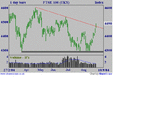TheBramble
Legendary member
- Messages
- 8,394
- Likes
- 1,171
JO - as has been described in another thread - yes, you can. The volatility of the price action in any given time period can be used as a proxy volume.JumpOff said:Since there is no volume component of forex data, I was wondering if volume could be implied by these differing patterns of price action?
Which also makes me think of a parallel with Market Profile approach.


